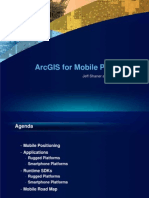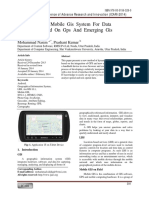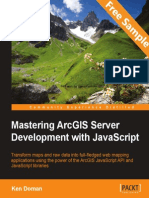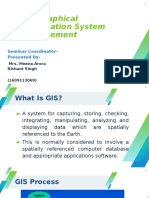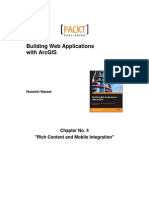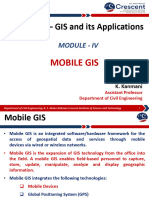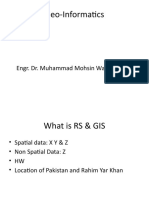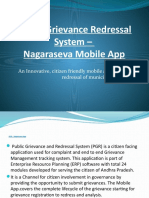Mobile GIS Guide
Getting your mobile GIS project off the ground
About The Author
Matt Sheehan is a mobile GIS pioneer. He and his staff at WebMapSolutions have been
providing clients with mobile GIS solutions since the earliest days of smartphones and
tablets.
We live in interesting times. Mobile and cloud computing are changing how and where we
are able to use technology. No longer are we limited to our home or office. Today
technology is accessible and usable wherever and whenever. And by technology we mean
computers: smartphones, tablets and the new phablets. We are talking about mobile
computers.
Mobility means changing location. This has made location and location based data and
analysis suddenly terribly important. Geographic Information Systems or GIS, is location
focused technology. It provides the means to collect, store, visualize and analyse any and
all location data.
We at the very beginnings of a revolution in location technology and GIS.
copyright(c)2014 www.webmapsolutions.com
1
�Mobile GIS Guide
Getting your mobile GIS project off the ground
Introduction
In this guide we will discuss mobile GIS. We will walk through the key terms and areas of
consideration when embarking on a mobile GIS project. Our goal is to help you better
understand this exciting new technology, and how it can help your organization.
copyright(c)2014 www.webmapsolutions.com
2
�Mobile GIS Guide
Getting your mobile GIS project off the ground
Table of Contents
1. Getting Started 4
Mobile GIS: The Basics
2. Web and Native Mobile Apps 5
Types of mobile GIS apps
3. GIS Cloud Technologies 6
The engine of your Mobile GIS app
4. Offline Mobile GIS 7
Finally offline mobile GIS is here
5. Mobile GIS Choices 8
What are your mobile GIS app
options?
6. Mobile GIS Frameworks 9
Flexible mobile solutions
copyright(c)2014 www.webmapsolutions.com
3
�Mobile GIS Guide
Getting your mobile GIS project off the ground
1. Getting Started
Mobile GIS: The Basics
Mobile GIS is the implementation of GIS on mobile devices such as smartphones, tablets
and phablets. It provides ways to visualize and analyse location based data. Maps are the
most common visualization method. This is often a combination of base map – satellite,
road, topographic etc – and point, line or polygon overlays. Maps are interactive, so
zoom and pan, with point, line and polygon layers overlaid. Tap a point which represents
a museum and basic information about the museum appears in a pop up. Often tools are
provided in mobile GIS apps such as geolocation ie. show my current location on the
map, and search eg. Find and show people or places nearby. Tools are often geared to
usage and user, so maintenance staff will require quite different options to tourists.
Mobile GIS is being used by an ever broader user base. No longer are they the bastion of
those trained in GIS. This has some important implications.
There are two key types of mobile GIS applications: Web and native. Web GIS apps run in
mobile browsers, relying on a URL. Native apps are those you download from online
stores such as Google Play and Apple's App Store. These are installed applications. We
will discuss Web and native mobile GIS apps in the next Chapter, and in particular the
notion of cross platform.
Mobile GIS apps do not live in isolation. They all rely on cloud based GIS services. Gone
are the days when we use shapefiles and Pdf's on mobile devices. Cloud based GIS means
Esri's ArcGIS, MapBox, GISCloud and any number of other sophisticated cloud based
services. Important choices need be made here.
Talk mobile technology and eventually screen size will be mentioned. Today we have a
plethora of mobile screen sizes: from the smallest 4” smartphone through to 10” tablets
and above. Screen size affect usability: the smaller the screen the more limited is
usability. This often brings up questions around cross device mobile applications.
copyright(c)2014 www.webmapsolutions.com
4
�Mobile GIS Guide
Getting your mobile GIS project off the ground
2. Web and Native Mobile Apps
Types of mobile GIS apps
Mobile GIS is confusing. We introduction some key terms and topics in the previous
chapter. Let's discuss in this chapter one of those topics. The different types of mobile
GIS apps: Web and native.
We are all familiar with Web applications. Often these are described as web pages. They
have unique URL's and run in browsers. Mobile Web GIS applications run in mobile
browsers. They are web applications designed for mobile devices. Pull up your mobile
Chrome browser on your iPhone or iPad, Android or Windows device, type in a URL and
your GIS app will load. All ready for use.
In contrast native mobile apps are installed applications, distributed via the various
mobile app stores. These are applications written specifically for each platform. That is
important. So one set of developers build the GIS app for all Apple devices. Another
group for Android. That's one mobile app written in multiple programming languages by
different development teams.
So which path do you follow for your mobile GIS project, Web or native? Much depends
here if you are opting for an off the shelf product or custom solution, discussed more in
Chapter 5. Let's presume here custom solution. From our experience 9 times out of 10
mobile Web is your best choice. Web is simply more flexible, and cost effective. A mobile
Web application can be written which is both cross platform and cross device. Think
about that. One application which runs on Apple, Android and Windows mobile devices. It
also looks good and is usable on all smartphones, tablets and phablets.
One other advantage of mobile Web GIS applications. They can be converted into native
apps. That's right. They can be turned into install-able apps distributed via the various
mobile app stores.
copyright(c)2014 www.webmapsolutions.com
5
�Mobile GIS Guide
Getting your mobile GIS project off the ground
3. GIS Cloud Technologies
The engine of your Mobile GIS app
Okay, lets next talk about the cloud. We need to consider which cloud GIS solution our
app will use. All the GIS muscle used by our application will be driven by the cloud
service we choose. More than that, all data we view or collect in the application will be
stored centrally. No more working with shapefiles and Pdf's on your mobile device, now
we will be using data accessible across the organization.
There are increasingly more cloud GIS services now available. These include Esri's ArcGIS,
MapBox, GISCloud and many others. Budget and functionality will be key determinates of
which makes the most sense for your project. Our preference is ArcGIS.
Esri are the worlds largest GIS solution provider. With over 40 years in the business, they
have the greatest breadth and depth in terms of services and solutions. With the
popularity of cloud technology, they have evolved their flagship ArcGIS product line into
a platform. What does that mean? Simply that mobile, Web, desktop and server GIS
solutions are now integrated into one larger whole.
Let's provide a solid example to show why we think a platform based GIS solution is
important. Imagine a maintenance team collecting data about work done in the field
using their mobile GIS Web app. The mobile app is pushing this data automatically to
ArcGIS server or ArcGIS Online in the cloud. Once uploaded the data can be viewed and
analysed across the organization. That means managers using executive dashboards, GIS
analysts using ArcMap, and much more.
The ability to share GIS data across an organization, and use tools which allow
integration and collaboration around this data is why we favor the ArcGIS platform as the
engine of mobile GIS apps.
copyright(c)2014 www.webmapsolutions.com
6
�Mobile GIS Guide
Getting your mobile GIS project off the ground
4. Offline Mobile GIS
Finally offline mobile GIS is here
Offline mobile GIS has been a hot topic over the last few years. Mobile GIS users have
been crying out for the ability to continue using their mobile GIS apps in remote areas
without wi-fi connectivity. Well finally offline mobile GIS is here.
In this eBook we could have mentioned offline in passing rather than devoting a chapter
to the topic. But offline is important. One might argue crucial for any and all mobile GIS
apps.
Offline GIS provides the ability to view maps and to edit data in areas which lack
Internet connectivity. Let's touch on the mechanics of offline. With no connectivity we
cannot view base maps, nor can we view our point, line and polygon layers. How do we
get past this problem? We store the base map and the layers on the mobile device itself.
Before we go offline, base maps can be downloaded dynamically. So select the area you
wish to view offline and wait as the base map tiles are downloaded to your device.
Another method is download already prepared base map packages. Layers similarly will
need to be stored on the mobile device. Usually a database on your mobile devices is
where all this data is stored.
Advanced GIS functionality, is not usually available in offline mode. So if your mobile GIS
app relies on ArcGIS server for example to process a request, while offline this will not
be available. But many other tools will be available. An important one being geolocation.
The GPS on a mobile device works regardless of wi-fi connectivity. So even in the most
remote areas you will still be able to find and view your current location.
Offline data collection and editing is also now possible. So drop a point on the map for
example, add attributes, attach an image then store in the local database. Once back
online this data is pushed up to the GIS cloud based server.
copyright(c)2014 www.webmapsolutions.com
7
�Mobile GIS Guide
Getting your mobile GIS project off the ground
5. Mobile GIS Choices
What are your mobile GIS app options?
When one considers the best option for any mobile GIS project, usually one has to choose
between an off the shelf product or custom solution.
Let's discuss off the shelf mobile GIS products first. Off the shelf means products which
have been built for a specific purpose. Search through Google Play or the Apple App Store
and you will find a list of apps which are labelled GIS. Be careful, if they are not tied to
a cloud GIS service they are very limited. For example, if shapefile is listed avoid.
As mentioned in Chapter 3, any decision you make on a mobile GIS app need be made in
parallel with your choice of GIS cloud service. Esri have two popular mobile apps ArcGIS
and Collector for ArcGIS available for Apple and Android devices. These apps are tied to
the ArcGIS Online cloud service. The app is free ArcGIS Online is not. GISCloud and others
have similar offerings.
If you have a fixed workflow in mind for your mobile GIS app, and these needs are
satisfied by an off the shelf product. Fantastic. As an example, Collector for ArcGIS has
been built for online and offline data collection and editing. It is a well designed, highly
functional mobile app. There are tools a plenty to satisfy many of your mobile editing
needs.
But, there are some key areas off the shelf mobile GIS products fall down, namely:
* They are usually not configurable.
* Cannot be extended to add functionality.
* Have fixed workflows which may not suite how your field based staff work.
Lets imagine we need a mobile GIS app which is to be used by non-GIS trained staff. So
simple workflows. You need to load both ArcGIS Server and ArcGIS Online layers directly.
And need custom forms which can be generated both online and offline. Imagine also the
apps requirements may change over time. No off the shelf product will provide this
flexibility.
copyright(c)2014 www.webmapsolutions.com
8
�Mobile GIS Guide
Getting your mobile GIS project off the ground
5. Mobile GIS Frameworks
Flexible mobile solutions
Let's step back and summarize where we are. We've discussed the difference between
Web and native apps, and suggested we prefer the flexibility of Web. Cloud GIS services
are a must for all mobile GIS projects, and we lean towards Esri's ArcGIS platform due to
the range of tools and level of integration. Offline we see as an essential component of
any mobile GIS app. We like off the shelf products but bemoan their lack flexibility.
If you get the idea that we favor flexibility, you are correct. One mobile GIS application
which runs across all popular mobile platforms: Apple, Android and Windows, and
devices: smartphones, tablets and phablets. A configurable application which can be
styled according to your needs, works both online and offline and can load data from
different sources. An application which is simple to use, designed for your specific
workflows and can be extended to provide custom functionality.
Step forward mobile GIS frameworks. In the crudest terms a mobile framework provides
the nuts and bolts to build custom mobile GIS applications. No need to reinvent the
wheel each time you need a mobile app. A framework helps make producing any mobile
GIS app fast and easy.
Years ago we yearned for a mobile GIS framework. With none available we went ahead
and built one. Its Web based, works online and offline, is configurable, and extensible.
This framework has transformed our mobile GIS app development process. Not only are
we building a vast array of apps using the framework. We can integrate it with existing
Web apps. Have a Web app you'd like to extend, maybe add GIS or offline, simply use our
framework.
Looking for maximum flexibility from your mobile GIS app: look to frameworks to do the
heavy lifting.
copyright(c)2014 www.webmapsolutions.com
9
� Mobile GIS Guide
Getting your mobile GIS project off the ground
These are exciting times for GIS. Mobile and cloud technology are transforming how and
where GIS is being used. Hopefully this guide provided you some useful information. Good
luck in your mobile GIS project journey.
copyright(c)2014 www.webmapsolutions.com
10




